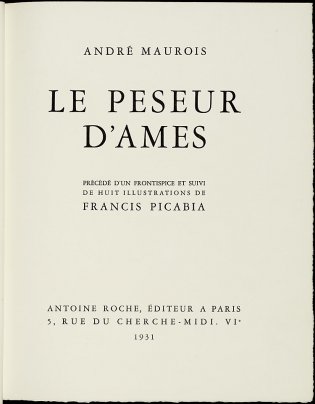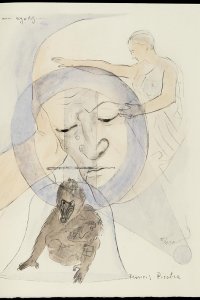Le peseur d'âmes
Year: 1931
Author: André Maurois (1885 - 1967)
Artist: Francis Picabia (1879 - 1953)
Publisher: Antoine Roche, éditeur
Bibliographical description
Description: Le peseur d'ames / André Maurois ; préc. d'un front. et suivi de 8 ill. de Francis Picabia. - Paris : ntoine Roche, éditeurhe, 1931. - 117 p., 8 bl. pl. : ill. ; 29 cm
1st edition: 1931
Printer: Ducros et Colas (Paris) (text) Daniel Jacomet (illustrations)
Edition: 366 copies
This copy: Number 178 of 318 on Arches
Note: With dedication from the author to Louis Koopman
Bibliography: Bénézit 10-866 ; Carteret IV-273 ; Édouard-Joseph III-128 ; Monod 7970
Shelfmark: KW Koopm A 144
References
- Maria Lluïsa Borràs, Picabia. London, Thames and Hudson, 1985
- Jan Paul Bresser, 'Eerste mediahype: vrouwen, auto's en rellen',in: Elsevier. (54) 1998, p. 91
- William A. Camfield, Francis Picabia: His art, life and times. Princeton, NJ,Princeton University Press, 1979
- Paul van Capelleveen, Sophie Ham, Jordy Joubij, Voices and visions. The Koopman Collection and the Art of the French Book. The Hague, Koninklijke Bibliotheek, National Library of the Netherlands; Zwolle, Waanders, 2009
- Paul van Capelleveen, Sophie Ham, Jordy Joubij, Voix et visions. La Collection Koopman et l'Art du Livre français. La Haye, Koninklijke Bibliotheek, Bibliothèque nationale des Pays-Bas; Zwolle, Waanders, 2009



